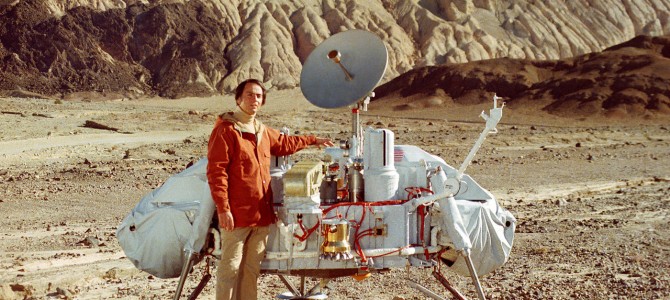
It might seem strange to say it, but I am a global warming skeptic because of Carl Sagan.
This might seem strange because Sagan was an early promoter of the theory that man-made emissions of carbon dioxide are going to fry the globe. But it’s not so strange when you consider the larger message that made Sagan famous.
As with many people my age, Sagan’s 1980 series “Cosmos,” which aired on public television when I was eleven years old, was my introduction to science, and it changed my life. “Cosmos” shared the latest developments in the sciences of evolution, astronomy, and astrophysics, but its real heart was Sagan’s overview of the history of science and the distinctive ethos behind the scientific method. Sagan returned again and again to one central theme: that the first rule of science is to follow the evidence wherever it leads, regardless of one’s wishes or preconceptions. He spoke eloquently about the Ancient Greek Pythagoreans and their attempt to suppress the facts about “irrational numbers” that didn’t fit their theory. And he spoke admiringly about the 17th-century astronomer Johannes Kepler, who started out pursuing a theory in which the planets move in circular orbits reflecting the ratios of the perfect Pythagorean solids—and ended up being driven by the evidence to reject this theory and discover completely new laws of planetary motion.
I didn’t end up becoming a scientist, but I absorbed Sagan’s basic lesson and have tried my best to adhere to it in my own field: follow the evidence wherever it leads.
But this can be a difficult rule to follow. It is easy to spot the unexamined assumptions of others, but harder to root out your own prejudices. A few years ago, while watching “Cosmos” again for the first time in 25 years, I was reminded that Sagan did not always practice what he preached, and his error sheds light on the global warming theory’s original sin against science. It is a sin that has only gotten worse and which explains the scandalous state of today’s debate over global warming.
In the third episode of “Cosmos,” Sagan presents our nearest planetary neighbors, Venus and Mars, as cautionary tales of what happens when a potentially Earth-like planet goes wrong and become inhospitable to life. In his telling, Venus is a warning about how a runaway greenhouse effect can turn a planet’s surface into an acidic furnace, while Mars is a cautionary tale about how an inadequate greenhouse affect can leave a planet cold, dry, and barren. He proceeds to apply these lessons to Earth, predicting two possible doomsday scenarios: one in which deforestation causes the Earth to cool, and one in which fossil fuels cause it to warm. (You can hear some of the audio here, but without Sagan’s original visuals.)
Human activities brighten our landscape and our atmosphere. Might this ultimately make an ice age here? At the same time we are releasing vast quantities of carbon dioxide, increasing the greenhouse effect…. It may not take much to destabilize the Earth’s climate, to convert this heaven, our only home in the Cosmos, into a kind of hell.
This is a bit of a cultural time capsule, preserving the precise moment at which scientific alarmists were switching from warning about a new ice age, in the 1970s, to warning about runaway warming.
Much of the planetary science behind these claims, by the way, turned out to be speculative and premature. In the 1990s, detailed satellite maps of Venus revealed the remains of enormous volcanoes and vast rivers of lava, implying that the planet had been entirely resurfaced by a volcanic apocalypse as recently as 100 million years ago—which strikes me as a much more reasonable explanation for why Venus has a surface temperature of 900 degrees and an atmosphere full of sulfuric acid. As for Mars, its much smaller size and lack of a planetary magnetic field, which allows its atmosphere to be stripped off by the solar wind, are adequate explanations for its cold, thin air and the absence of surface water. So Venusian SUVs and overenthusiastic Martian loggers are probably off the hook.
To his credit, Sagan admits that the science on this subject is still in its early stages—but then he makes a disastrous error.
And yet we ravage the Earth at an accelerated pace, as if it belonged to this one generation, as if it were ours to do with as we please…. Our generation must choose. Which do we value more: short-term profits or the long-term habitability of our planetary home?…
The study of the global climate, the sun’s influence, the comparison of the Earth with other worlds, these are subjects in their earliest stages of development. They are funded poorly and grudgingly, and meanwhile we continue to load the Earth’s atmosphere with materials about whose long-term influence we are almost entirely ignorant.
Can you see the error? Sagan enters this topic with a clear animus against the profit motive and a pre-established belief that industrial civilization is “ravaging the earth.” These are the obvious cultural biases of a late-20th-century modern liberal. So he considers two alternative theories—that we are destroying the planet by cooling it down, or we are destroying the planet by heating it up—and calls for more government funding to figure out which is correct. But his bias prevents him from seriously considering the obvious third option: that our effect on the Earth’s climate is negligible, any heating or cooling is within the normal range of natural variation, and the benefits of industrial civilization far outweigh any negative effects. But if we don’t treat this as an option, much less as an equally likely option, no government funding is likely to be devoted to pursuing that theory.
This is the original sin of the global warming theory: that it was founded in a presumption of guilt against industrial civilization. All of the billions of dollars in government research funding and the entire cultural establishment that has been built up around global warming were founded on the presumption that we already knew the conclusion—we’re “ravaging the planet”—and we’re only interested in evidence that supports that conclusion.
That brings us to where we are today. The establishment’s approach to the scientific debate over global warming is to declare that no such debate exists—and to ruthlessly stamp it out if anyone tries to start one.
That’s how we get the Los Angeles Times loftily declaring that it won’t even publish letters to the editor that question global warming. That’s how we get Michael Mann’s lawsuit attempting to make it a legally punishable offense to “question his intellect and reasoning.”
That’s how we get the appalling petition to spike Charles Krauthammer’s Washington Post‘s column for expressing mere agnosticism about global warming.
It’s how we get the New York Times casually suggesting that global warming “deniers” should be stabbed.
And then there is this doozy, from my own backyard: at the University of Virginia, Thomas Forman II declares in the student newspaper that global warming skeptics shouldn’t even be allowed to speak on campus, because “we should keep our debates out of our science classes.”
This, at the university founded by Thomas Jefferson, who said, “here we are not afraid to follow truth wherever it may lead, nor to tolerate any error so long as reason is left free to combat it.” He also said, “It is error alone which needs the support of government. Truth can stand by itself.”
Forman is the president of the UVA Environmental Sciences Organization, which “provides a link between the Environmental Sciences Department and the students of the University,” “mainly geared toward undergraduate majors and minors in the department.” So the guy who believes in keeping debate out of our science classes has appointed himself as a guide for every undergraduate who wants to enter the field of climate science.
This puts a whole new light on the claim that a “consensus” of climate scientists backs global warming. It’s easy to manufacture such a consensus when you decree ahead of time that no contrary opinion may be heard. When I saw the recent claim that 97% of climate scientists endorse the theory of catastrophic man-made global warming, it struck me that this is the same margin by which dictators typically claim they have won re-election—and for the same reason. These are both systems in which voting for the “wrong” result is not tolerated.
To see how fanatical this atmosphere of intolerance has become, consider the case of Bjorn Lomborg, who does not even question whether man-made global warming is occurring, but merely argues that it would cost the world far more to stop carbon dioxide emissions than it would to ameliorate the effects of global warming. For this heresy, he had his funding specifically cut off by the Danish government and has had to move into a kind of voluntary exile in Prague. A long profile of Lomborg describes how he has been ostracized merely for questioning the economic and political policies for dealing with global warming. Which is revealing in itself, because it implies that it is the political end result, the campaign to impose massive taxes and restrictions on fossil fuels, that is the fixed assumption to which science must bend.
This is why I treat scientific claims about global warming with such skepticism: I would give them a lot more credence if I thought anyone was allowed to come up with a different answer. As I observed in the Mann vs. Steyn case, if it is a sin to doubt, then there is no science.
That’s a lesson I learned from Carl Sagan, and while he had some role in launching the current global warming orthodoxy, I suspect he would be appalled at the unscientific fanaticism with which it is now enforced. Consider Sagan’s treatment of Immanuel Velikovsky, whose crackpot theories about the development of the solar system enjoyed a brief vogue in the middle of the 20th century. After dissecting the various absurdities of Velikovsky’s theory, Sagan offered this conclusion:
The worst aspect of the Velikovsky affair is not that many of his idea were wrong or silly or in gross contradiction to the facts. Rather, the worst aspect is that some scientists attempted to suppress Velikovsky’s ideas. The suppression of uncomfortable ideas may be common in religion or in politics, but it is not the path to knowledge, and there is no place for it in the endeavor of science.
Let this serve as an answer—and a rebuke—to today’s global warming establishment.
Follow Robert on Twitter.









